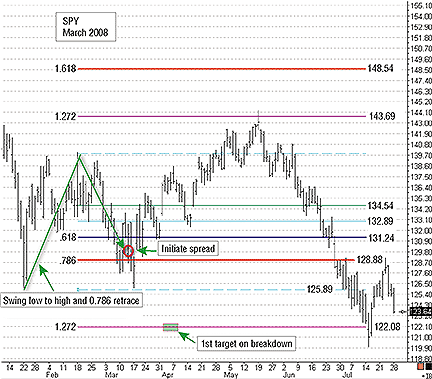Options
Checkmate
A Flexible Strategy For Volatile Markets
Profit from option spreads on the S&P 500 by applying the same tactic as you would playing chess. Here’s how.
Good chess players are always focusing on a couple of moves in advance of the current one being considered. They are peering out into the future of possible opponent maneuvers and thinking of ways to counter them. We can apply the same principle when we’re looking at how to profit (up, down, and flat) with option spreads on the Standard & Poor’s 500 (Spy) through the exchange traded fund (Etf). Here’s a breakdown and analysis of a real strategy.
Rationale for initial strategy
The first part of this strategy was initiated on March 14, 2008. At the time, the Spys were in the process of testing the lows made two months earlier in January 2008, around the 126–127 levels. (See Figure 1.)
At the time, the Spy had the potential to break support to the downside because of the fear and confusion in the markets. If it did break support, I wanted to be able to profit from that move. I had specific downside price targets based on Fibonacci extensions of the last impulse move up. A break to the downside would also support the volatility (vega) component of the spread and add to profitability. Generally, falling prices support a rise in volatility.

Figure 1: price chart of spy. The SPYs were in the process of testing the lows made two months earlier in January 2008 around the 126–127 levels.
On the other hand, the markets also reached extreme negative sentiment measures, technical support, and indicator divergence, which could favor a surprise snapback rally. With that scenario, I wanted to find a way to profit as well. Taking all of that into consideration, I decided to start off with an April/June put diagonal spread on the Spy.
A put diagonal spread is a time spread that will buy further-month options at one strike and sell the same amount of options at a different strike in the front (closest) month. This allows us to profit over a range of prices over time, and the spread can be morphed into other strategies to take advantage of changing market conditions.